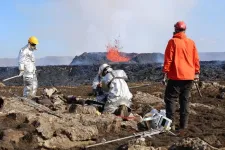(Press-News.org) A study led by a Brigham investigator evaluated a novel device that automatically measures blood pressure at the wrist, generating hundreds of readings within days that may help clinicians determine cardiovascular risk and improve hypertension care
High blood pressure, the leading risk factor for death worldwide, is present in one in every two adults. Only one-quarter of individuals with hypertension have their blood pressure under control, highlighting the need for innovative strategies for blood pressure management. A study led by an investigator from Brigham and Women’s Hospital, a founding member of the Mass General Brigham healthcare system, evaluated a cuffless monitor that uses optical sensors to record blood pressure continually and efficiently, without disruption to the patient. The study, published in Frontiers in Medicine, highlights promising advancements in hypertension diagnosis, risk assessment and management that may be enabled by use of cuffless devices.
“The successful management of hypertension depends on patients being able to take blood pressure measurements easily and reliably outside of the traditional doctor’s office setting,” said corresponding author Naomi Fisher, MD, of the Division of Endocrinology, Diabetes and Hypertension at Brigham and Women’s Hospital. “Cuffless devices have the potential to revolutionize hypertension management. They provide many more readings than traditional devices, during both the day and night, which can help confirm the diagnosis of hypertension and guide medication titration.”
Medical guidelines increasingly recommend the incorporation of at-home blood pressure monitoring into hypertension diagnosis and management. This is because isolated blood pressure readings taken at a clinician’s office may be inaccurate: for some, blood pressure tends to rise in medical settings (“white coat hypertension”) while others have normal blood pressure during examination despite hypertensive readings at home (“masked hypertension”).
Time-in-target-range (TTR) describes how often a patient’s blood pressure is in the normal range, and it is emerging as a promising metric of cardiovascular risk. But TTR requires more frequent blood pressure readings that can feasibly be obtained by patients with traditional blood pressure cuffs, which can be inconvenient, burdensome and sometimes uncomfortable for patients.
Fisher, who designed and led the study, collaborated with co-authors from Aktiia SA, a Swiss biotechnology company, to analyze over 2.2 million blood pressure readings from 5,189 subjects in Europe and the U.K. who wore a cuffless wrist monitor manufactured by Aktiia. On average, the Aktiia device collected 29 readings per day, a substantial increase from the number of blood pressure readings patients typically take with home devices (guidelines recommend four per day, which is more than most patients measure). Over a 15-day period, the researchers obtained an average of 434 readings from each patient.
By calculating TTR over a 15-day period, the researchers were able to risk stratify participants by percentage of readings in target range and compare these classifications to those generated via traditional measurement patterns, using either 24-hour or week-long daytime monitoring schedules. They found that the traditional methods misclassified 26 and 45 percent of subjects, respectively, compared to the reference TTR. They determined that continual monitoring for seven days is required to obtain 90 percent or greater accuracy in hypertension risk classification, a frequency of measurement that may only be possible with cuffless monitors.
Though the cuffless device studied here has not been approved by the U.S. Food and Drug Administration, it has been validated in multiple studies and is available for over-the-counter purchase in Europe and the U.K. Work to evaluate and set standards for such devices in the U.S. is ongoing.
“For the first time, by using a cuffless device, we can collect continual out-of-office blood pressure readings and use these data to calculate a new metric, time-in-target-range, which shows great promise as a predictor of risk,” Fisher said. “The use of cuffless devices could create a shift in the paradigm of blood pressure monitoring and hypertension management.”
Authorship: Fisher’s co-authors on the paper include Tiago P. Almeida, David Perruchoud, Jay Shah, and Josep Sola.
Disclosures: Fisher serves as a consultant for Aktiia SA. Almeida, Perruchoud, Shah, and Sola are employees of Aktiia SA.
Funding: No financial support was received for this research.
Paper cited: Fisher, ND et al. “Optimizing Time-in-Target-Range Assessment for Blood Pressure: Insights from a Large-Scale Study with Continual Cuffless Monitoring” Frontiers in Medicine DOI: 10.3389/fmed.2024.1396962
###
END
Iceland’s ongoing volcanic eruptions may continue on and off for years to decades, threatening the country’s most densely populated region and vital infrastructure, researchers predict from local earthquake and geochemical data.
The eruptions on the Reykjanes Peninsula have forced authorities to declare a state of emergency, with a series of eight eruptions having occurred since 2021. This southwestern region is home to 70 percent of the country’s population, its only international airport, and several geothermal power plants that supply ...
A new Child Development study by researchers at the University of Maryland, Furman University, Education Northwest and University of Hawaiʻi at Manoa in the United States, examined whether children think it’s unfair for a teacher to select students from only one gender or ethnic group for leadership duties.
Researchers learned that children and adolescents are not only aware of these situations, but they are also motivated to rectify these types of inequalities in the classroom. Understanding ...
Research suggests that phone use may have an effect on children’s speech input and language development. However, most of the prior work in this area examines parents and children in controlled laboratory experiments in public spaces and may not be representative of daily interactions between a child and their caregivers.
New research in Child Development by the University of Texas at Austin in the United States is the first to combine objective markers of speech (via audio recorders worn by infants) and maternal cell phone use from cell phone logs. This research helps document ...
For decades, it’s been thought that people with heart failure should drastically reduce their dietary salt intake, but some studies have suggested that salt restriction could be harmful for these patients. A recent review in the European Journal of Clinical Investigation that assessed all relevant studies published between 2000 and 2023 has concluded that there is no proven clinical benefit to this strategy for patients with heart failure.
Most relevant randomized trials were small, and a single large, ...
Research published in Terra Nova provides insights into the ongoing eruption series on the Reykjanes Peninsula in Iceland that began in 2021. The eruptions forced the evacuation of an entire town, with an uncertain future about the possibility for residents to return.
For the study, investigators analyzed information from local earthquakes and geochemical data on lava samples erupted through time. The combined evidence implies that the lavas that have erupted in recent years were derived from a moderately-sized magma reservoir ...
A new study that looked for relationships between early social media use and depression across adolescence and into young adulthood found that certain factors may make social media more risky or protective regarding depression. The findings, which are published in the Journal of Adolescence, suggest that social media use does not impact all adolescents in the same way, and an individualized approach is needed to determine the benefits and harms of social media on young people’s mental health.
For the study, 488 adolescents living in the United States were surveyed once a year for 8 years ...
Based on focus groups with children and young people with peanut allergy, experts have published guidance for clinicians working in the UK’s National Health Service (NHS) to help them safely and equitably implement Palforzia® peanut oral immunotherapy. Their recommendations are published in Clinical & Experimental Allergy.
In 2022, the National Institute for Health and Care Excellence in the UK recommended the use of Palforzia®—which has defatted peanut powder as its active ingredient—for desensitizing children ...
Worldwide, introduced non-native herbivores have the potential to threaten native ecosystems. For example, in western North America, uncontrolled numbers of feral horses and burros are threatening natural habitats and the native wildlife that rely on them. New research published in the wildlife research journal Wildlife Monographs documents the impact that non-native burros are having on plant and animal life in the Sonoran Desert of North America.
Investigators found that the presence of burros was associated with changes to long-lived plants important to the region. In areas with established burro herds, researchers documented lower ground cover, plant density, and foliage density, ...
Ambient temperatures are associated with over 5 million premature deaths worldwide every year, more than 300,000 of which in Western Europe alone. In a context of rapidly warming temperatures that successively broke previous records during the last two decades, it is essential to use epidemiological models to develop novel, impact-based early warning systems predicting the health effects of forecast temperatures.
This is precisely what the Adaptation group at the Barcelona Institute for Global Health (ISGlobal), a centre supported by the "la Caixa" Foundation, has done: Forecaster.health is the first pan-European, open-access platform using sex- and age-specific epidemiological ...
As critical pollinators, bees keep our agricultural systems going — but human-caused changes to the planet heavily impact their foraging options. To help protect our food security, we need more information about bees’ own dietary requirements. Scientists writing in Frontiers in Sustainable Food Systems studied the nutritional value of 57 types of pollen and found that bees need to forage from a variety of plants to balance their diet between fatty acids and essential amino acids.
“Despite public interest and a rise in pollinator plantings, little is known ...




